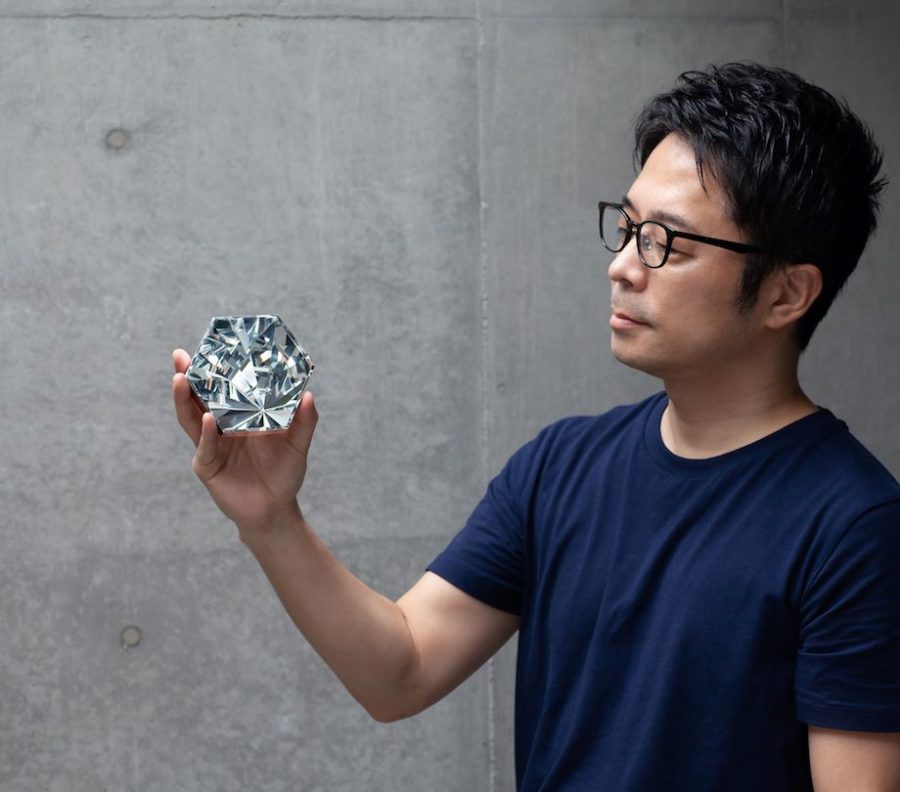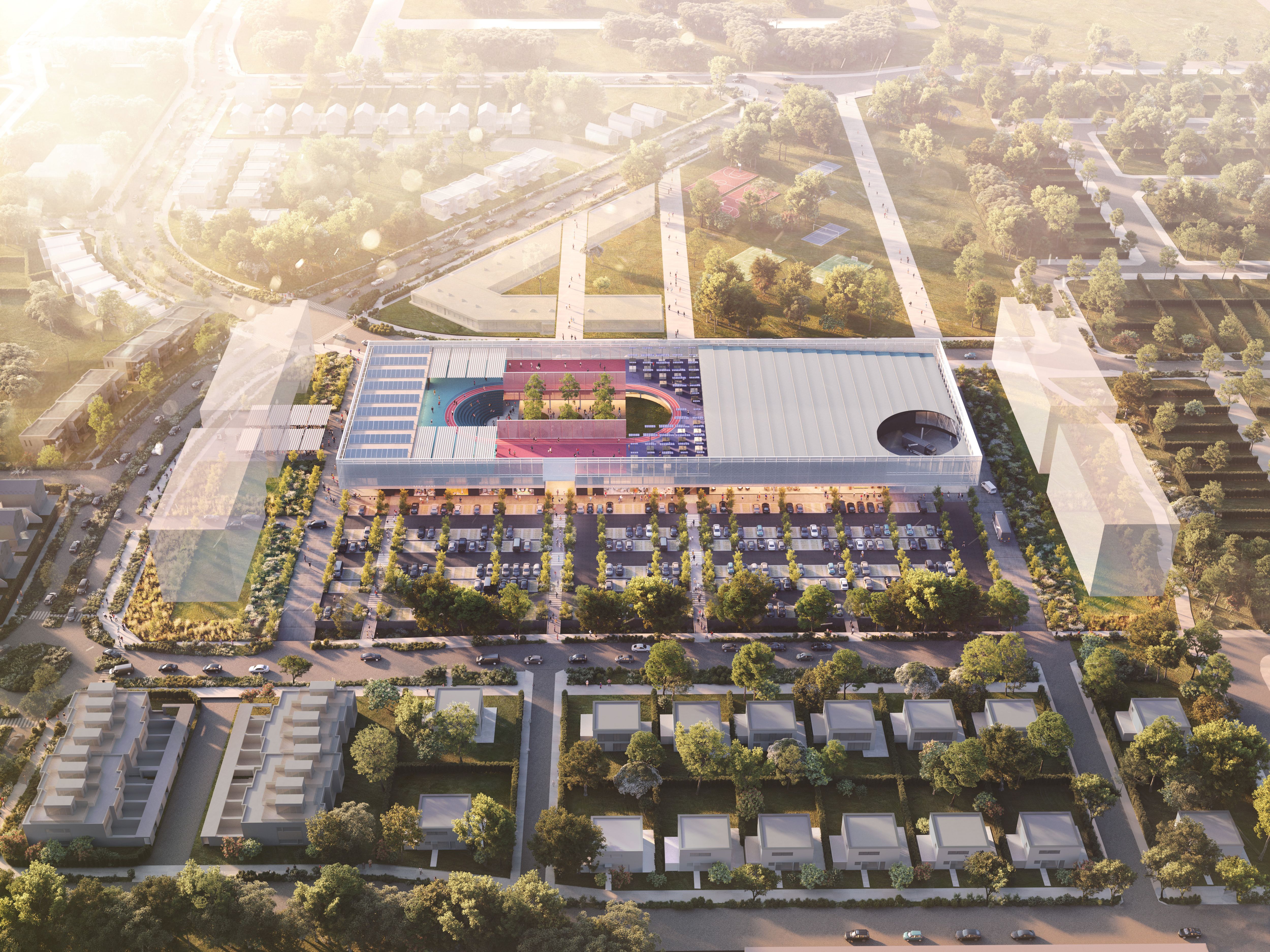
CULTURE

©︎ Tapio Snellman
フィンランドのヘルシンキに建つ〈アモス・レックス(Amos Rex)〉は、既存の市民空間である広場を維持しつつ地下に設けられた美術館です。
カーブを描くルーフスケープと天窓が、地上に都市の公園としての場をつくり出すと同時に、地中のギャラリースペースと地上を視覚的につなげています。ヘルシンキを拠点に活動するJKMMアーキテクツ(JKMM Architects)が設計しました。
(以下、JKMM Architectsから提供されたプレスキットのテキストの抄訳)

©︎ Mika Huisman

©︎ HANNU RYTKY
ヘルシンキに建つ美術館〈アモス・レックス〉は、フィンランドの慈善家・アートコレクター・実業家として知られるアモス・アンダーソン氏(1878-1961)の遺贈により設立されたアモス・アンダーソン美術館(1965-2017)の活動を引き継ぎ2018年に建てられた。
街の中心部に位置する〈アモス・レックス〉は、1920年代の古典主義建築である国会議事堂の向かいにあり、スティーヴン・ホールが設計した〈キアズマ美術館〉の斜め向かいに位置する。

©︎ Mika Huisman

©︎ TUOMAS UUSHEIMO
市民の広場を保ちつつギャラリースペースを生み出す地下美術館
〈アモス・レックス〉へは、レストラン、ショップ、映画館であるビオ・レックス(Bio Rex)、そしてその背後に広がる広場からなる1930年代に建てられたラシパラツィ(Lasipalatsi:ガラスの宮殿)を通って入り、ギャラリースペースはすべて地下にある。
ラシパラツィ広場の地下に6,230m²の建物を設計するという大胆なアプローチは、19世紀に建てられた新古典主義様式の兵舎が隣接するという、歴史的にデリケートな文脈に後押しされたものである。

©︎ Mika Huisman
歴史的な建物と広場を維持しつつ更新した都市の公園
この兵舎を保存する上で、かつての軍事パレード場(現在のラシパラツィ広場)を建築のない未建築の公共空間として残すことが条件となっていた。
JKMMはヘルシンキ市のプランナーと協力し、市の重要な市民空間であるラシパラツィ広場を維持しつつ、〈アモス・レックス〉において地上に現れる唯一の建築物である屋根を市民が楽しめるようにすることとした。

©︎ Mika Huisman
これにより、地下の展示スペースに太陽光を取り入れるという課題にも対応する、彫刻的なルーフライトがもたらされたのである。
新たな地形をつくり出すルーフライトは、そのなだらかなフォルムが広場の一体感を保ちつつ、都市における公園を演出している。

©︎ TUOMAS UUSHEIMO

©︎ TUOMAS UUSHEIMO
内部からも街とつながる地上レベルの天窓
ギャラリー・スペースから鉄骨コンクリート製の天窓を見上げると、JKMMにより丁寧に検討された、上部に広がる街路レベルへの眺望を通し、街とのつながりを感じることができる。
建築家たちは、来館者が地下6mにいても、街にいると感じられる「場所」の感覚を体験することが重要だと考えたのである。

©︎ TUOMAS UUSHEIMO
美術館設計の観点からは、大きなドーム型天窓の構造により柱のない2,200m²の展示ホールを実現した。この無柱空間は、展示のためのフレキシブルなスペースとなるだろう。
このホールのスケールは、天井のドームとその歴史的なイメージが独特のドラマを生み出し、畏敬の念を抱かせる。トップライトから差し込む繊細な光の質は、歴史的な教会などに見られる高所に位置する窓「クリアストーリー」からもたらされるものに似ている。

©︎ TUOMAS UUSHEIMO

©︎ TUOMAS UUSHEIMO
JKMMの創立パートナーであり、〈アモス・レックス〉の代表建築家であるアスモ・ヤークシ(Asmo Jaaksi)は次のように語る。
「〈アモス・レックス〉プロジェクトの一環として、フィンランドの1930年代の建築物であるラシパラツィを統合することは感慨深い経験であった。この特別な場所に大胆な新しいレイヤーを加えることで、私たちは過去と現在を結びつけたのだと感じている。」
「私たちは、これがシームレスな拡張であると同時に、非常にエキサイティングなミュージアムスペースであることを伝えたい。緩やかなカーブを描く天井ドームのある新しいラシパラツィ広場が、ヘルシンキの都市文化に歓迎され、街の誰もが自分たちのものだと感じられる場所として受け入れられてほしい。」

©︎ TUOMAS UUSHEIMO

©︎ TUOMAS UUSHEIMO
歴史的なラシパラツィの建物と一体的に運用するアート施設
ミュージアムの内部には展示ホールからラシパラツィのホワイエへと続くスロープ階段があり、来館者はビオ・レックス映画館のドアから建物に入る。
JKMMは、550人収容可能な映画館のオーディトリアムを、ラシパラツィの残りの部分とともに修復した。この映画館は美術館の来館者だけでなく一般客にも開放されており、アートハウス映画とメインストリーム映画などを上映している。

©︎ Mika Huisman

©︎ TUOMAS UUSHEIMO
Korjaamoというアート団体によって運営されているこの映画館は、〈アモス・レックス〉と共同で映画祭やその他のイベントも開催している。
ラシパラツィの建物と合わせると、美術館の総面積は13,000m²強になる。建築的にも文化的にも、進化する都市というヘルシンキのアイデンティティは、〈アモス・レックス〉プロジェクトを構想する上で最も重要なものであった。

©︎ TUOMAS UUSHEIMO

©︎ TUOMAS UUSHEIMO

©︎ HANNU RYTKY

©︎ HANNU RYTKY

©︎ HANNU RYTKY

©︎ HANNU RYTKY

©︎ AARO ARTTO

Outdoor diagram

Diagram

Site plan

1F plan

2F plan

-1F plan

Elevation

Elevation

Section

Section

Section

Detail

Detail

Detail
以下、JKMM Architectsのリリース(英文)です。
PROJECT INFORMATION
Date of Completion: August 2018
Building program: Galleries, office and supporting back office spaces, commercial, technical and logistical spaces
Size of the planning area: 13,000 m²
New Galleries Area: 2,200 m²
Total excavation for gallery: 13,000 cubic metres
Client: Föreningen Konstsamfundet and The City of Helsinki
Project Cost: €50 million
Date of original Lasipalatsi and Bio Rex Building: Completed 1936. Built to designs by Viljo Revell, Heimo Riihimäki and Niilo KokkoJKMM TEAM
Asmo Jaaksi: main architect, architect SAFA
Freja Ståhlberg-Aalto: project architect, architect SAFA
Katja Savolainen: project architect, architect SAFA
Teemu Kurkela: architect SAFA
Samuli Miettinen: architect SAFA
Juha Mäki-Jyllilä: architect SAFA
Edit Bajsz: architect SAFA
Christopher Delany: architect
Markus Manninen: architect SAFA
Marko Pulli: architect
Katariina Takala: BIM coordinator
Jarno Vesainterior: architect
Jussi Vepsäläinen: architect
Päivi Meuronen: Interior architect SIO
Noora Liesimaa: Interior architect SIOGALLERY TECHNICAL SPECIFICATION
The flexible use of the exhibition spaces is guaranteed through a dense technical grid:
technical floor units, including power, data and supply air: 2.7 x 2.7 m grid
floor attachment points and connections for partition walls: 2.7 x 2.7 m grid
ceiling hanging points: 2.7 x 2.7 m grid, à 3kN (300kg)
ceiling lighting solution: continuous lightning track 2.7 x 2.7 m grid
floor load-bearing: 10kN(1000kg)/m²
floor point load-bearing: 75kN (7500kg)/ 25m²
advanced museum air environment (HVAC)Interesting details:
Number of ceiling discs in exhibition spaces: 8600
Number of wooden blocks in flooring: 220.000 à 10x10cm
Number of lighting fixtures in entrance lobby: 319
Elevator for museum logistics: 3 x 6 m, 40kN (4000kg)
Height of the highest dome in the main exhibition hall: 9,45 m
Main exhibition space: 30 x 32 m = 930 m²PROJECT PARTIES
Project Management: Haahtela-rakennuttaminen Oy
Structural design: Sipti Oy
Structural design of the domes: Sweco Rakennetekniikka Oy
HVAC engineering: Ramboll Talotekniikka Oy
Electrical engineering: Ramboll Talotekniikka Oy
Acoustics and sound proofing: Helimäki Akustikot Oy
Fire consultant: L2 Paloturvallisuus Oy
Main lobby ceiling lightning system: Doctor Design Oy / Petri VainioDESCRIPTION
Designed by Finnish practice JKMM, Amos Rex – a major new art museum in Helsinki – is completed in summer 2018. Amos Rex continues the work of Amos Anderson Art Museum (1965-2017) that was established at the bequest of Amos Anderson (1878-1961), a highly regarded Finnish philanthropist, art collector and entrepreneur.
Located in the heart of the city, Amos Rex is sited across from the 1920s classicist Parliament building and diagonally opposite the Steven Holl designed Kiasma Museum. The entrance to Amos Rex is through Lasipalatsi (“glass palace”), a distinguished 1930s Functionalist pavilion comprising restaurants, shops, the Bio Rex cinema and an open square behind it. All the new build gallery spaces of Amos Rex, however, are underground. This radical approach to designing a 6,230 square metre building below Lasipalatsi Square was driven by the historically sensitive context of the neighbouring 19th century neo-classical barracks. The listing of the barracks was contingent on the retention of the former military parade ground – now Lasipalatsi Square – as an unbuilt open public space.
JKMM worked with the City planners to determine how Lasipalatsi Square would remain as an important civic space within Helsinki while also allowing the public to enjoy Amos Rex’s only visible new built elevation, its roofscape. The solution came in the form of highly sculptural roof lights that also address the challenge of bringing daylight into the subterranean exhibition spaces. The roof lights create a new topography, their gently rolling forms playing on the idea of an urban park in keeping with the integrity of the square.
Inside the gallery spaces, visitors looking up to the generous steel-framed concrete skylights will feel connected to the city through JKMM’s carefully considered views opening out to the street-level above. The architects have felt it especially important for visitors to experience a sense of place, to feel located in a specific part of the city even when they are six metres below ground.
From a museum design point of view, the structure of the large domed skylights has enabled JKMM to shape a column-free 2,200 square metre exhibition hall. Curators will find this a flexible space in which to mount exhibitions. The hall’s scale is awe-inspiring with the ceiling domes, and their historical associations, creating their own particular sense of drama. The subtle quality of light in the top-lit exhibition hall is similar to that achieved through clerestory lighting.Asmo Jaaksi, founding partner at JKMM and the head architect of Amos Rex says,
“Integrating one of Finland’s architecturally pioneering 1930s buildings – Lasipalatsi – as part of the Amos Rex project has been a moving experience. By adding a bold new layer to this special site, we feel we are connecting past with present. We would like this to come across as a seamless extension as well as an exciting museum space very much of its time. We would like the new Lasipalatsi Square with its gently curving ceiling domes to be received as a welcome addition to Helsinki’s urban culture; a place everyone and anyone in the city can feel is their own.”Inside the Museum, sloping stairs lead up from the exhibition hall to Lasipalatsi’s foyer where visitors enter the building through the 1930s doors of the Bio Rex cinema. This forms a harmonious connection between new and existing buildings. JKMM has restored the 550-seat cinema auditorium together with rest of the listed Lasipalatsi Pavilion. This will be open to the general public as well as to museum visitors and show both art house and mainstream films. The cinema will be operated by an arts organisation called Korjaamo who will also run film festivals and organise other events in collaboration with Amos Rex.
Together with the Lasipalatsi Pavilion, the museum complex extends to just over 13,000 square metres. From an architectural and a cultural perspective, Helsinki’s evolving urban identity has been paramount in conceiving the Amos Rex project, a truly exciting new centre for the visual arts.The Museum’s Director, Kai Kartio, describes its curatorial programme,
“Our guiding principle has been to create a space that takes into consideration changes in art as well as ever-evolving ways in which art is made and presented. Content-wise, Amos Rex rests on three pillars: experimental, technically innovative contemporary art; 20th century Modernism, and ancient cultures.”
「Amos Rex Museum」JKMM Architects 公式サイト
https://jkmm.fi/work/amos-rex-museum-interior/









